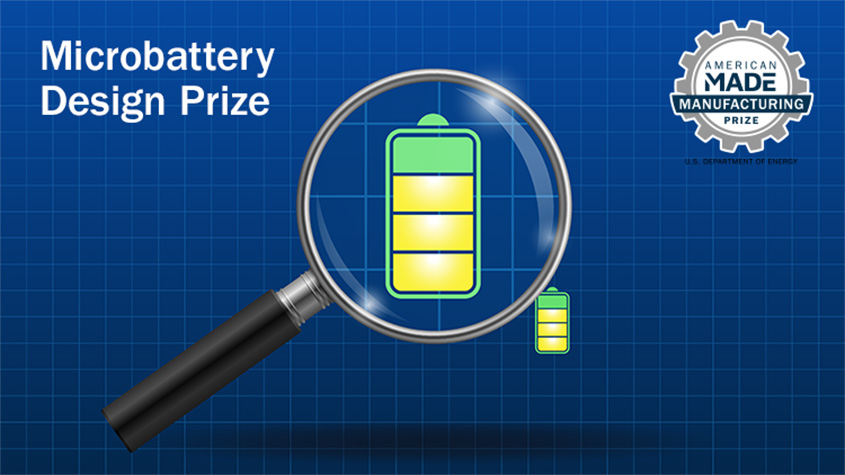New Prize Aims To Accelerate Microbattery Advances and Adoption
Novel Designs Could Help Power Smartwatches, Cities, Manufacturing, and a Clean Energy Grid
The first smartwatches mostly just tallied up steps or nagged users to stand up. But today, wearable medical devices can track stress levels and sleep cycles or monitor for irregular heartbeats, ovulation cycles, and low blood oxygen levels; they can even sense a COVID-19 infection before symptoms start.
As these and other wireless electronic devices become more popular, they are getting smaller, too. And smaller devices need tinier batteries that can keep up with their powerful capabilities.
That is why the U.S. Department of Energy (DOE) Advanced Materials and Manufacturing Technologies Office just launched the Microbattery Design Prize, the newest prize challenge in the American-Made Challenges program to be administered by the National Renewable Energy Laboratory (NREL).
The prize, which opened for applications on March 8, 2023, offers a total prize pool of $1.1 million in federal funding and performance and safety testing services with DOE national laboratories. During two prize phases, selected teams will compete to design microbatteries that can outperform today’s models in performance, safety, and recyclability.

“Microelectronics have transformed society over the past 50 years, in large part because they continue to shrink,” said Tina Kaarsberg, a technology manager at DOE who is leading microelectronics research. “The same computing power that once filled a large room now fits under my finger.”
Watches are not the only devices that have gotten smart.
Sensors and other electronic devices are building smart homes, factories, farms, and cities. Soon, a whole suite of rice-grain-sized devices could monitor indoor air quality, factory safety hazards, bridge conditions, plant health, and heart conditions. Sensors powered with microbatteries could also smarten up manufacturing processes—helping to accelerate the development of clean energy technologies—and monitor a clean energy grid. As the country adds more renewable energy sources to the U.S. power system, these sensors could help ensure the grid continues to provide a steady stream of reliable energy.
To keep all these tiny devices running, their batteries must be even smaller. New battery designs could not only help run this smart world; they could also be tailored to serve specific applications and offer improved efficiency, performance, and safety. But, so far, building smaller batteries that deliver the same (or more) power has proven to be a big challenge.
Manufacturers, for example, cannot make microbatteries with the existing, large-scale processes they use to make larger batteries. Because microbatteries use different chemistries from their bigger counterparts and manufacturers cannot produce as many at a time, the microbattery manufacturing process can often be more expensive. And that extra cost makes it harder to test out new microbattery designs and get them ready for commercial use.
That is where DOE’s Advanced Materials and Manufacturing Technologies Office comes in.
“Supporting the prototyping and testing of more microbattery designs can provide the key link between potential system developers, users, and battery manufacturers to spur their adoption and increase manufacturing capacity for batteries of this size,” said Paul Syers, a technology manager at DOE.
Individuals and teams are eligible to compete in the Microbattery Design Prize, which is divided into two prize phases, called Idea and Test:
- During the Idea Phase, competitors will develop technical designs for microbatteries that serve a specific application (like an implanted medical device) and meet certain performance goals (like a specific power output). Up to six winning teams will be given the opportunity to complete battery performance and/or safety testing work at a DOE national laboratory.
- Only Idea Phase winners may participate in the Test Phase. During this second phase, competitors will manufacture their prototypes and evaluate their performance and safety as well as their potential cost. By the end of this contest, participants will develop a realistic plan to commercialize and manufacture their technology.
One grand prize winner will receive $300,000 in cash, and up to two additional teams will each receive $175,000 in cash.
Improved microbatteries could come with increased power capacities, safety measures, and versatility. Some of these microbattery advances could be applied to larger batteries, too, boosting broader efforts to improve energy storage. But they could also help the microbattery manufacturing industry develop new, optimized processes, increase domestic production, and build reliable supply chains.
Eventually, these incremental shifts could help the United States compete with international manufacturers and accelerate the country’s transition to a clean energy future through smarter manufacturing and grids.
“The Microbattery Design Prize seeks to advance microbattery design and manufacturing,” said Alec Schulberg, the NREL prize administrator, “so we can power our smart future.”
Learn more about how to participate in the Microbattery Design Prize.
Last Updated May 28, 2025
